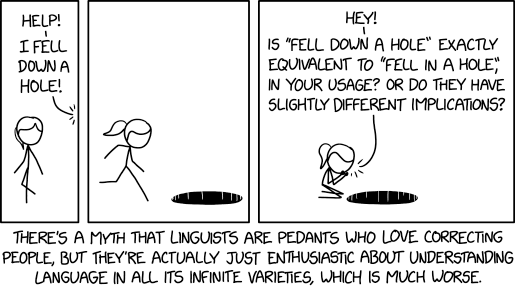A Real Character, and a Philosophical Language
A couple of decades ago, in response to a long-forgotten taxonomic proposal, I copied into antique html Jorge Luis Borges' essay "El Idioma Analítico de John Wilkins", along with an English translation. This afternoon, a reading-group discussion about algorithms for topic classification brought up the idea of a single universal tree-structured taxonomy of topics, and this reminded me again of what Borges had to say about Wilkins' 1668 treatise "An Essay Towards a Real Character, And a Philosophical Language". You should read the whole of Borges' essay, but the relevant passage for computational taxonomists is this:
[N]otoriamente no hay clasificación del universo que no sea arbitraria y conjetural. La razón es muy simple: no sabemos qué cosa es el universo. "El mundo – escribe David Hume – es tal vez el bosquejo rudimentario de algún dios infantil, que lo abandonó a medio hacer, avergonzado de su ejecución deficiente; es obra de un dios subalterno, de quien los dioses superiores se burlan; es la confusa producción de una divinidad decrépita y jubilada, que ya se ha muerto" (Dialogues Concerning Natural Religion, V. 1779). Cabe ir más lejos; cabe sospechar que no hay universo en el sentido orgánico, unificador, que tiene esa ambiciosa palabra. Si lo hay, falta conjeturar su propósito; falta conjeturar las palabras, las definiciones, las etimologías, las sinonimias, del secreto diccionario de Dios.
[I]t is clear that there is no classification of the Universe that is not arbitrary and full of conjectures. The reason for this is very simple: we do not know what thing the universe is. "The world – David Hume writes – is perhaps the rudimentary sketch of a childish god, who left it half done, ashamed by his deficient work; it is created by a subordinate god, at whom the superior gods laugh; it is the confused production of a decrepit and retiring divinity, who has already died" ('Dialogues Concerning Natural Religion', V. 1779). We are allowed to go further; we can suspect that there is no universe in the organic, unifying sense, that this ambitious term has. If there is a universe, its aim is not conjectured yet; we have not yet conjectured the words, the definitions, the etymologies, the synonyms, from the secret dictionary of God.
Read the rest of this entry »

